Location of Biorefineries Based on Olive-Derived Biomass in Andalusia, Spain
Abstract
1. Introduction
2. Materials and Methods
2.1. Case Study
2.2. Biomass Supply
2.3. Methodology Description
2.3.1. Map Building
2.3.2. Building of the Biomass Source Location Map
2.3.3. Protected Areas and Characterisation of the Territory: Map Building
2.3.4. Environmental Fragility Map
2.3.5. Site Selection
3. Results and Discussion
3.1. Olive-Derived Biomass Availability
3.2. Environmental and Territorial Analysis
3.3. Environmental Fragility of the Study Area
3.4. Proposed Areas for the Implementation of Biorefineries Based on Olive-Derived Biomass
4. Conclusions
Author Contributions
Funding
Institutional Review Board Statement
Informed Consent Statement
Data Availability Statement
Conflicts of Interest
References
- IRENA. International Renewable Energy Agency. Available online: https://www.irena.org/ (accessed on 25 October 2020).
- EU Parliament and Council Directive. 2018/2001 on the promotion of the use of energy from renewable sources (recast). Off. J. Eur. Union 2018, 328, 82–209. [Google Scholar]
- Sikora, A. European green deal—Legal and financial challenges of the climate change. ERA Forum. 2021, 21, 681–697. [Google Scholar] [CrossRef]
- REN21. Renewables 2020 Global Status Report (Paris: REN21 Secretariat); REN21: Paris, France, 2020; ISBN 978-3-948393-00-7. [Google Scholar]
- ETIP Bioenergy. Bioenergy in Europe. 2020. Available online: https://etipbioenergy.eu/images/ETIP_B_Factsheet_Bioenergy in Europe_rev_feb2020.pdf (accessed on 30 November 2020).
- Rasool, U.; Hemalatha, S. A review on bioenergy and biofuels: Sources and their production. Braz. J. Biol. Sci. 2016, 3, 3–21. [Google Scholar] [CrossRef]
- FAOSTAT. Food and Agriculture Organization of the United Nations. 2021. Available online: http://www.fao.org/faostat/en/#data/QC (accessed on 2 March 2021).
- Manzanares, P.; Ruiz, E.; Ballesteros, M.; Negro, M.J.; Gallego, F.J.; López-Linares, J.C.; Castro, E. Residual biomass potential in olive tree cultivation and olive oil industry in Spain: Valorization proposal in a biorefinery context. Span. J. Agric. Res. 2017, 15, e0206. [Google Scholar] [CrossRef]
- López-Linares, J.C.; Gómez-Cruz, I.; Ruiz, E.; Romero, I.; Castro, E. Production of ethanol from hemicellulosic sugars of exhausted olive pomace by Escherichia coli. Processes 2020, 8, 533. [Google Scholar] [CrossRef]
- López-Linares, J.C.; Ruiz, E.; Romero, I.; Castro, E.; Manzanares, P. Xylitol production from exhausted olive pomace by Candida boidinii. Appl. Sci. 2020, 10, 6966. [Google Scholar] [CrossRef]
- Romero-García, J.M.; Niño, L.; Martínez-Patiño, C.; Álvarez, C.; Castro, E.; Negro, M.J. Biorefinery based on olive biomass. State of the art and future trends. Bioresour. Technol. 2014, 159, 421–432. [Google Scholar] [CrossRef]
- Sánchez, P.; Ruiz, M.V. Production of pomace olive oil. Grasas y Aceites 2006, 57, 47–55. [Google Scholar] [CrossRef]
- Hingsamer, M.; Jungmeier, G. Biorefineries. In The Role of Bioenergy in the Emerging Bioeconomy, 1st ed.; Lago, C., Caldés, N., Lechón, Y., Eds.; Elsevier: Amsterdam, The Netherlands, 2018; pp. 180–221. [Google Scholar]
- Martínez-Patiño, J.C.; Romero-García, J.M.; Ruiz, E.; Oliva, J.M.; Álvarez, C.; Romero, I.; Negro, M.J.; Castro, C. High solids loading pretreatment of olive tree pruning with dilute phosphoric acid for bioethanol production by Escherichia coli. Energy Fuels 2015, 29, 1735–1740. [Google Scholar] [CrossRef]
- Romero-García, J.M.; Martínez-Patiño, C.; Ruiz, E.; Romero, I.; Castro, E. Ethanol production from olive stone hydrolysates by xylose fermenting microorganisms. Bioethanol 2016, 2, 51–65. [Google Scholar] [CrossRef]
- Serrano-Hernandez, A.; Faulin, J. Locating a biorefinery in northern Spain: Decision making and economic consequences. Socioecon. Plann. Sci. 2019, 66, 82–91. [Google Scholar] [CrossRef]
- Kurian, J.K.; Raveendran, G.; Hussain, N.A.; Raghavan, G.S.V. Feedstocks, logistics and pre-treatment processes for sustainable lignocellulosic biorefineries: A comprehensive review. Renew. Sustain. Energy Rev. 2013, 25, 205–219. [Google Scholar] [CrossRef]
- Al-Najjar, H.; Pfeifer, C.; Al Afif, R.J.; El-Khozondar, H. Estimated view of renewable resources as a sustainable electrical energy source, case study. Designs 2020, 4, 32. [Google Scholar] [CrossRef]
- Wei, B.; Luo, J.; Maiga, Q. Application of ArcGIS spatia lanalysis technology insite selection of high way dump. West. China Commun. Sci. Technol. 2019, 7, 10–13. [Google Scholar]
- Ruiz-Arias, J.A.; Terrados, J.; Pérez-Higueras, P.; Pozo-Vázquez, D.; Almonacid, G. Assessment of the renewable energies potential for intensive electricity production in the province of Jaén, southern Spain. Renew. Sust. Energ. Rev. 2012, 16, 2994–3001. [Google Scholar] [CrossRef]
- MAPAMA. Anuario de Estadística Agroalimentaria. Ministerio de Agricultura, Alimentación y Medio Ambiente, Gobierno de España. 2014. Available online: https://www.mapa.gob.es/es/estadistica/temas/publicaciones/anuario-de-estadistica/ (accessed on 11 December 2020).
- Adami, S.F.; Coelho, R.M.; Chiba, M.K.; de Moraes, J.F.L. Environmental fragility and susceptibility mapping using geographic information systems: Applications on Ribeirão do Pinhal watershed (Limeira, state of São Paulo). Acta Sci. Technol. Mar. 2012, 34, 433–440. [Google Scholar] [CrossRef]
- REDIAM (Environmental Information Network of Andalusia). Available online: http://www.juntadeandalucia.es/medioambiente/site/rediam (accessed on 14 December 2020).
- FEGA (Fondo Español de Garantía Agraria). Ministerio de Agricultura, Pesca y Alimentación. Available online: https://sigpac.mapa.gob.es/fega/visor/ (accessed on 22 January 2021).
- Ruiz, E.; Romero-García, J.M.; Romero, I.; Manzanares, P.; Negro, M.J.; Castro, E. Olive-derived biomass as a source of energy and chemicals. Biofuels Bioprod. Biorefin. 2017, 11, 1077–1094. [Google Scholar] [CrossRef]
- Junta de Andalucía. 2021. Available online: http://www.juntadeandalucia.es/medioambiente/site/portalweb (accessed on 10 February 2021).
- Manfré, L.A.; Silva, A.M.D.; Urban, R.C.; Rodgers, J. Environmental fragility evaluation and guidelines for environmental zoning: A study case on Ibiuna (the Southeastern Brazilian region). Environ. Earth Sci. 2013, 69, 947–957. [Google Scholar] [CrossRef]
- Suardi, A.; Bergonzoli, S.; Alfano, V.; Scarfone, A.; Pari, L. Economic distance to gather agricultural residues from the field to the integrated biomass logistic centre: A Spanish case-study. Energies 2019, 12, 3086. [Google Scholar] [CrossRef]
- Serna-Loaiza, S.; García-Velásquez, C.A.; Cardona, C.A. Strategy for the selection of the minimum processing scale for the economic feasibility of biorefineries. Biofuels Bioprod. Bioref. 2019, 13, 107–119. [Google Scholar] [CrossRef]
- Bruins, M.E.; Sanders, J.P.M. Perspective: Small scale processing of biomass for biorefinery. Biofuels Bioprod. Bioref. 2012, 6, 135–145. [Google Scholar] [CrossRef]
- Susmozas, A.; Moreno, A.D.; Romero-García, J.M.; Manzanares, P.; Ballesteros, M. Designing an olive tree pruning biorefinery for the production of bioethanol, xylitol and antioxidants: A techno-economic assessment. Holzforschung 2019, 73, 15–23. [Google Scholar] [CrossRef]
- Gutiérrez, M.C.; Rosas, J.M.; Rodríguez-Cano, M.A.; López-Luque, I.; Rodríguez-Mirasol, J.; Cordero, T. Strategic situation, design and simulation of a biorefinery in Andalusia. Energy Conv. Manag. 2019, 182, 201–214. [Google Scholar] [CrossRef]
- Romero-García, J.M.; Sanchez, A.; Rendón-Acosta, G.; Martínez-Patiño, J.C.; Ruiz, E.; Magaña, G.; Castro, E. An olive tree pruning biorefinery for co-producing high value-added bioproducts and biofuels: Economic and energy efficiency analysis. Bioenerg. Res. 2016, 9, 1070–1086. [Google Scholar] [CrossRef]
- Martínez-Patiño, J.C.; Ruiz, E.; Cara, C.; Romero, I.; Castro, E. Advanced bioethanol production from olive tree biomass using different bioconversion schemes. Biochem. Eng. J. 2018, 137, 172–181. [Google Scholar] [CrossRef]
- Gómez-Cruz, I.; Cara, C.; Romero, I.; Castro, E.; Gullón, B. Valorization of exhausted olive pomace by an eco-friendly extraction process of natural antioxidants. Antioxidants 2020, 9, 1010. [Google Scholar] [CrossRef] [PubMed]
- Gómez-Cruz, I.; Contreras, M.D.M.; Romero, I.; Castro, E. A biorefinery approach to obtain antioxidants, lignin and sugars from exhausted olive pomace. J. Ind. Eng. Chem. 2021, 96, 356–363. [Google Scholar] [CrossRef]
- Manzanares, P.; Ballesteros, I.; Negro, M.J.; González, A.; Oliva, J.M.; Ballesteros, M. Processing of extracted olive oil pomace residue by hydrothermal or dilute acid pretreatment and enzymatic hydrolysis in a biorefinery context. Renew. Energy 2020, 145, 1235–1245. [Google Scholar] [CrossRef]
- Padilla-Rascón, C.; Ruiz, E.; Romero, I.; Castro, E.; Oliva, J.M.; Ballesteros, I.; Manzanares, P. Valorisation of olive stone by-product for sugar production using a sequential acid/steam explosion pretreatment. Ind. Crop. Prod. 2020, 148, 112279. [Google Scholar] [CrossRef]
- Lama-Muñoz, A.; Contreras, M.D.M.; Espínola, F.; Moya, M.; Romero, I.; Castro, E. Optimization of oleuropein and luteolin-7-o-glucoside extraction from olive leaves by ultrasound-assisted technology. Energies 2019, 12, 2486. [Google Scholar] [CrossRef]
- Lama-Muñoz, A.; Contreras, M.D.M.; Espínola, F.; Moya, M.; Romero, I.; Castro, E. Content of phenolic compounds and mannitol in olive leaves extracts from six Spanish cultivars: Extraction with the Soxhlet method and pressurized liquids. Food Chem. 2020, 320, 126626. [Google Scholar] [CrossRef] [PubMed]
- Contreras, M.D.M.; Lama-Muñoz, A.; Gutiérrez-Pérez, J.M.; Espínola, F.; Moya, M.; Romero, I.; Castro, E. Integrated process for sequential extraction of bioactive phenolic compounds and proteins from mill and field olive leaves and effects on the lignocellulosic profile. Foods 2019, 8, 531. [Google Scholar] [CrossRef] [PubMed]
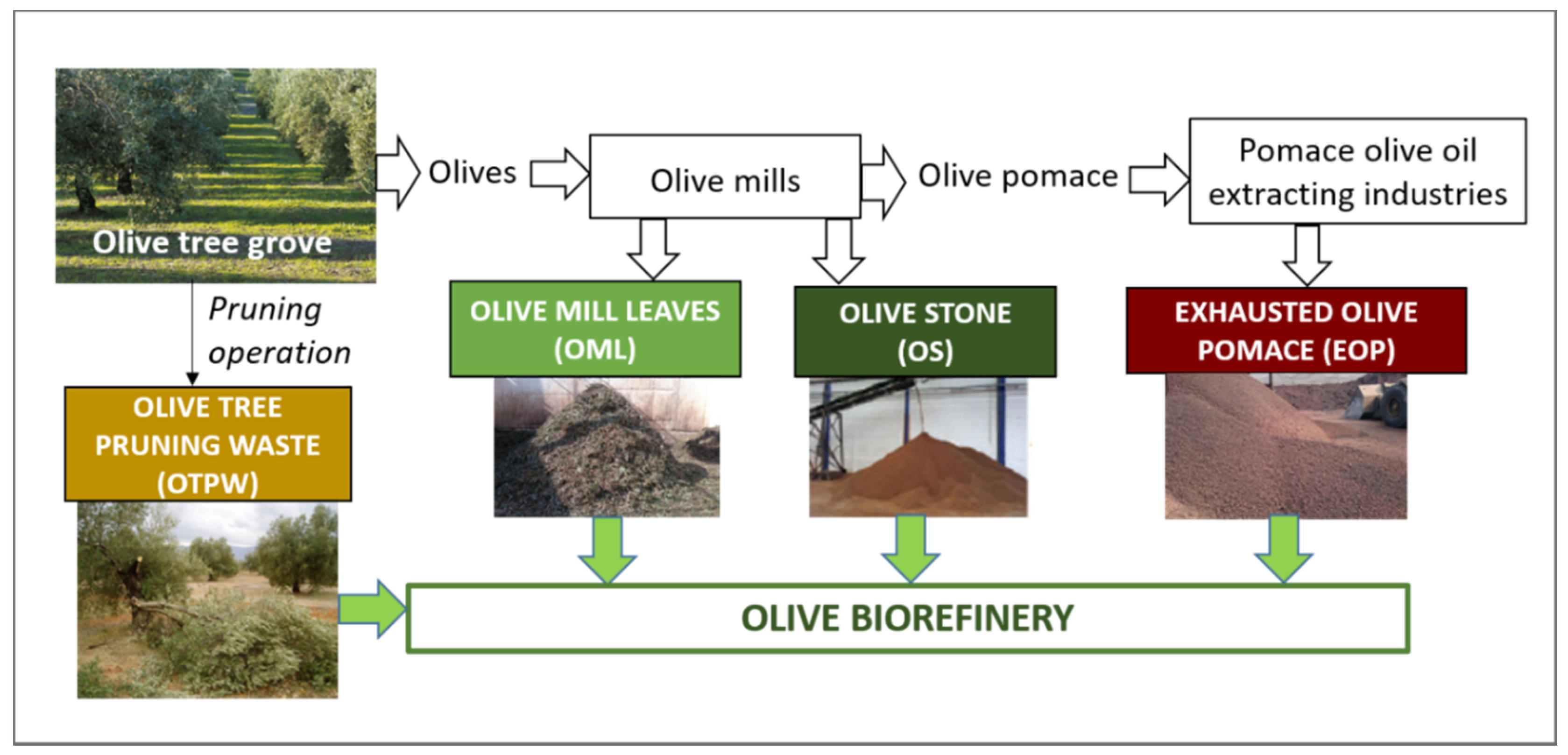

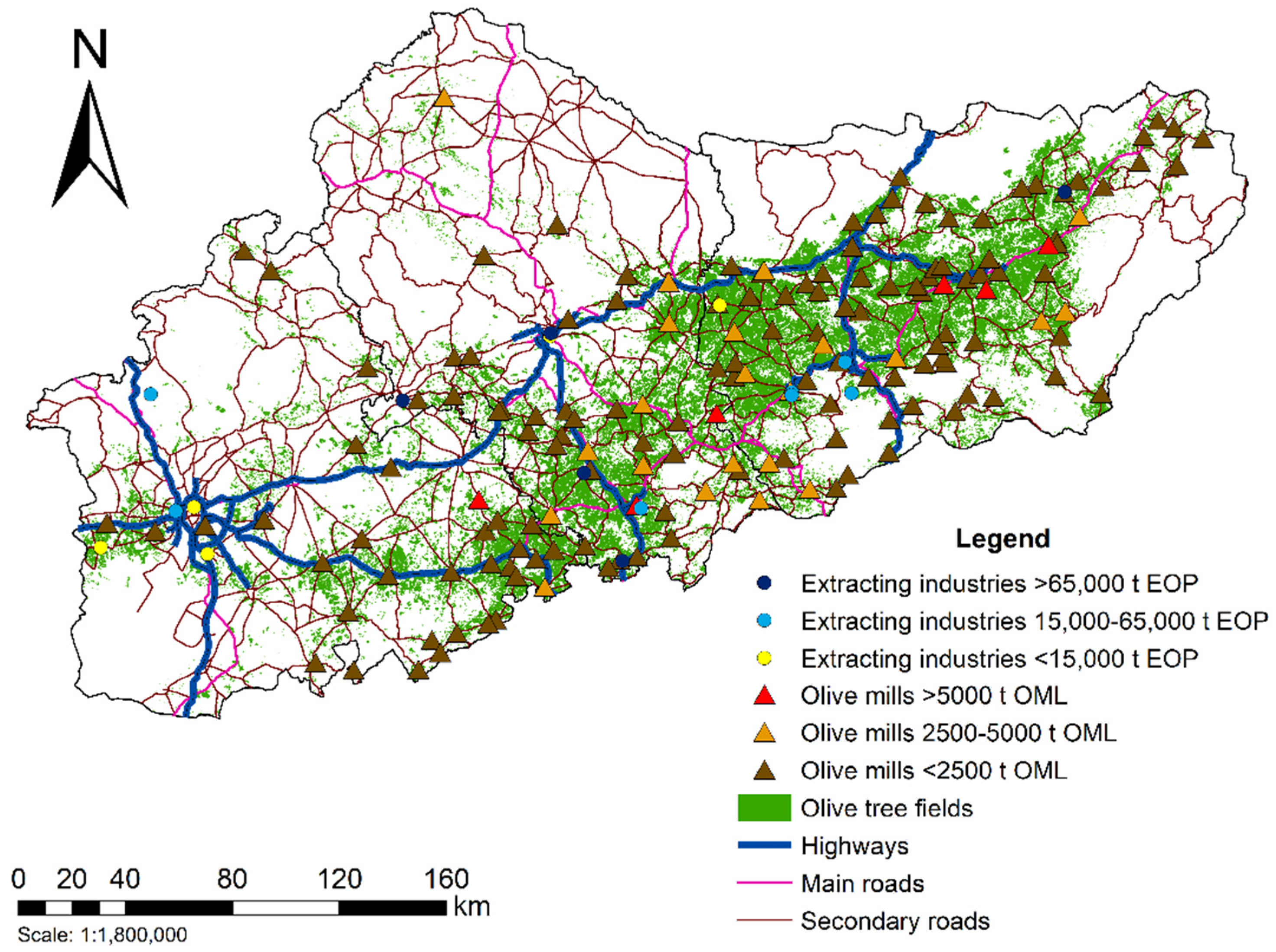
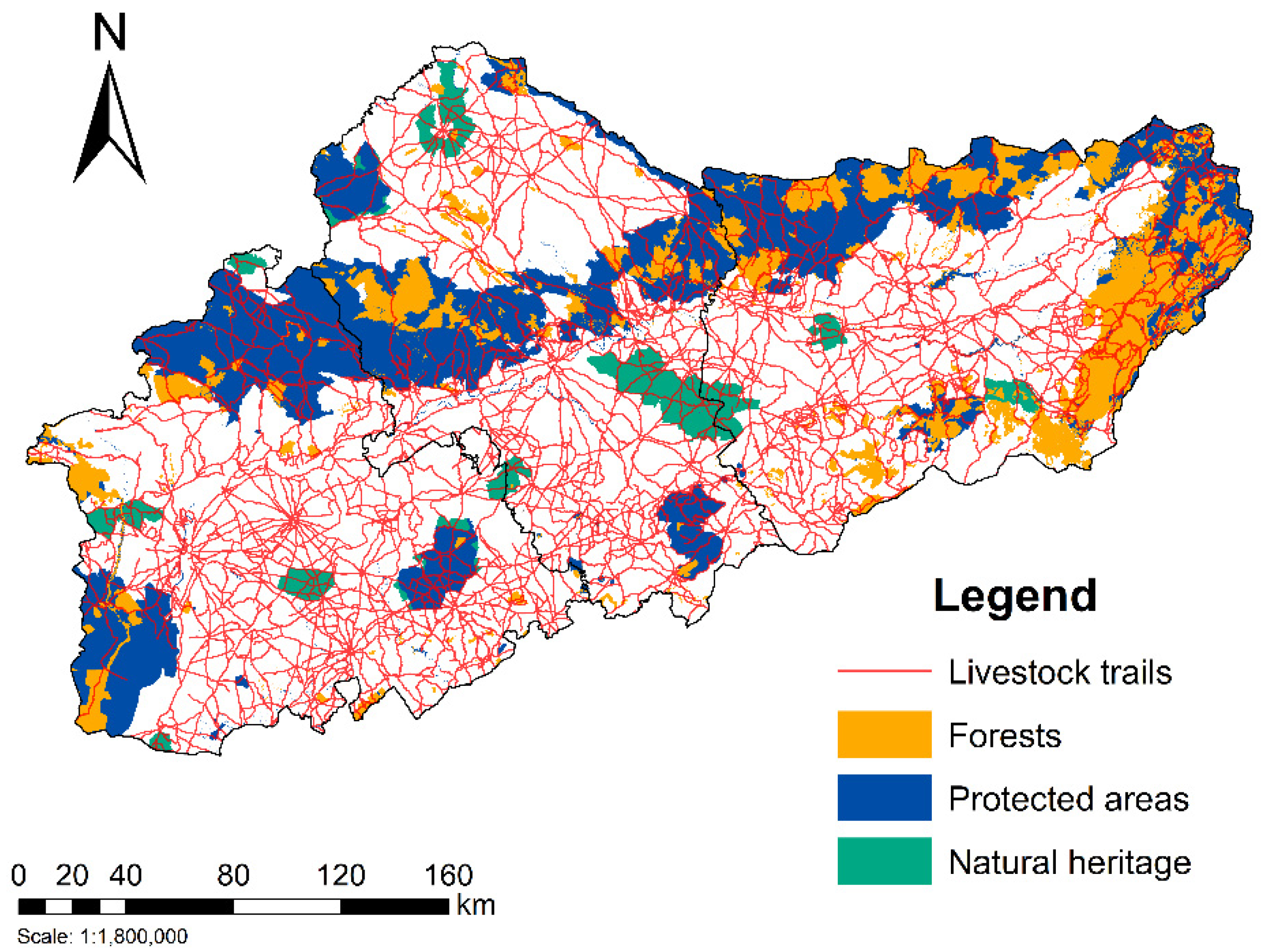


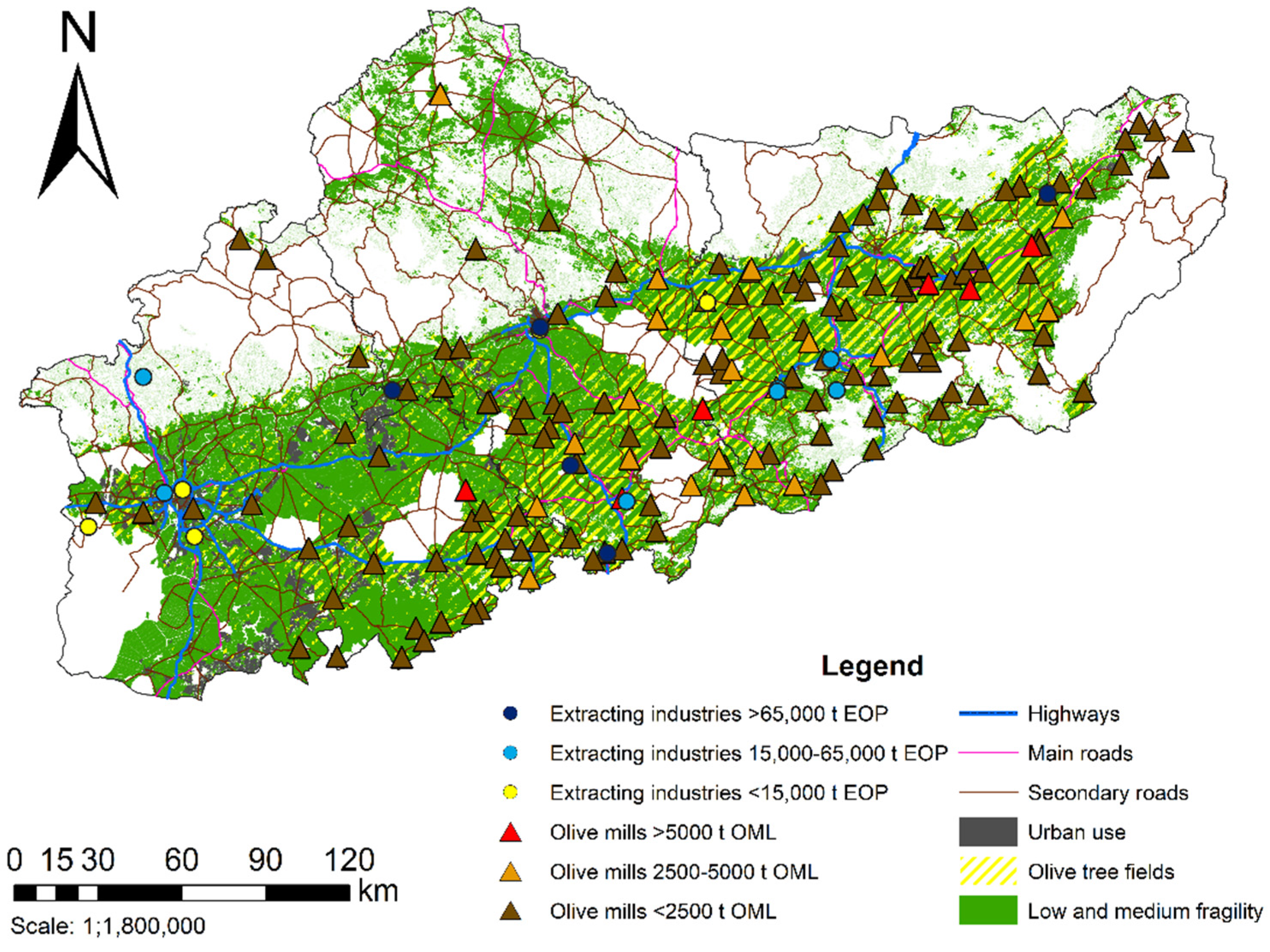
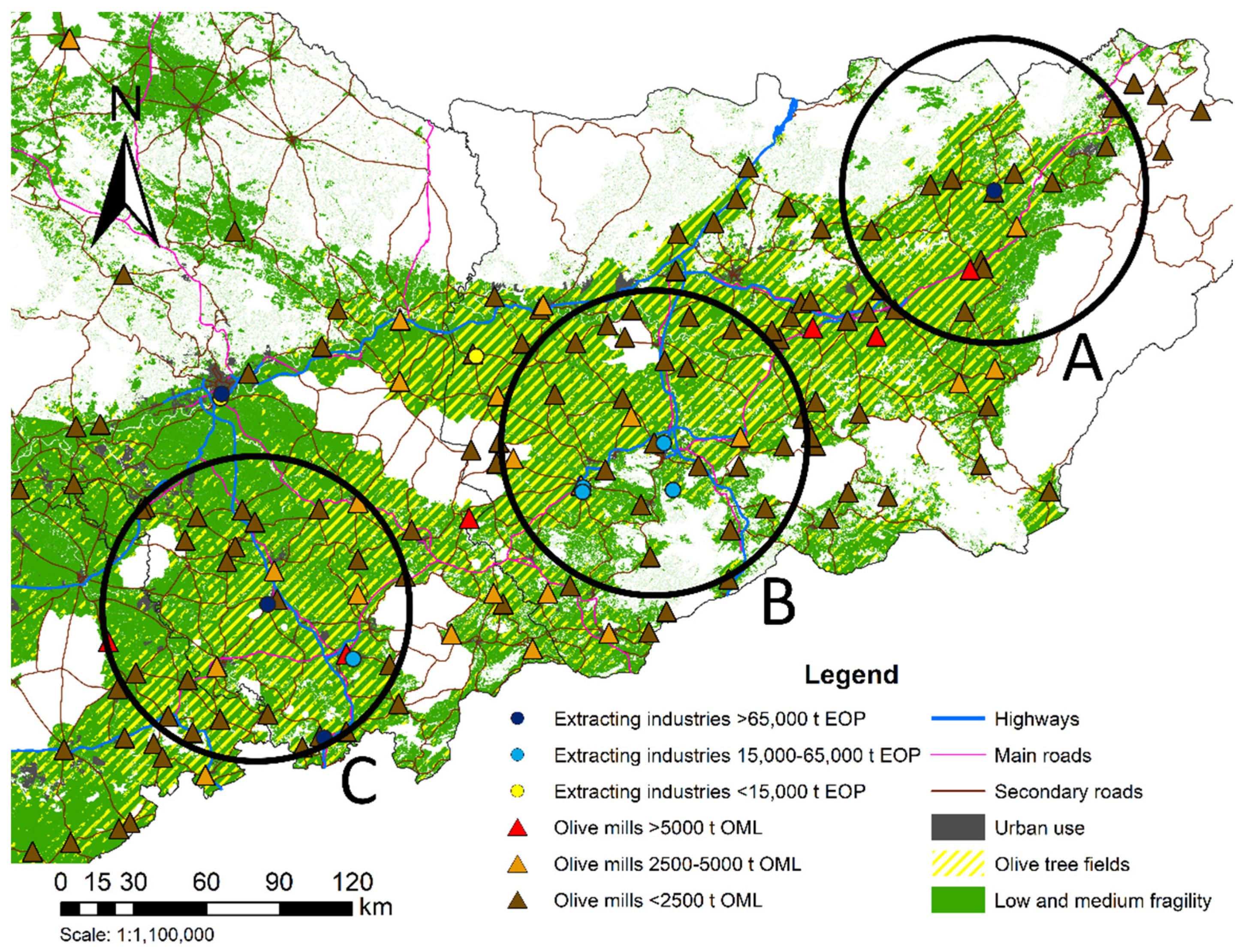
| Fragility | Land Use and Cover | * Area (%) |
|---|---|---|
| Very high | Protected areas | 19 |
| High | Natural vegetation, hydrographic network and livestock trails | 35 |
| Medium | Croplands | 41 |
| Low | Urban and industrial areas | 5 |
| Category | Area (ha) | OTPW (t) |
|---|---|---|
| Irrigation and slope > 10% | 61,176 | 97,882 |
| Irrigation and slope < 10% | 113,982 | 193,770 |
| Without irrigation and slope < 10% | 325,417 | 520,667 |
| Without irrigation and slope > 10% | 370,367 | 518,514 |
| Olive Mills | Extracting Plants | ||
|---|---|---|---|
| Olive Mill Leaves (t) | Olive Stones (t) | Exhausted Olive Pomace (t) | |
| Jaén | 118,408 | 179,678 | 319,226 |
| Córdoba | 76,284 | 115,757 | 530,246 |
| Seville | 32,811 | 49,789 | 64,584 |
| Total | 227,503 | 345,224 | 914,056 |
| Biomass Amount (t) | |||
|---|---|---|---|
| Option A | Option B | Option C | |
| Crop Fields | |||
| Olive tree Pruning Biomass | |||
| Non-irrigation and slope > 10% | 64,912 | 100,679 | 75,956 |
| Non-irrigation and slope < 10% | 43,526 | 69,553 | 109,101 |
| Irrigation and slope > 10% | 8842 | 22,445 | 11,887 |
| Irrigation and slope < 10% | 8912 | 25,275 | 29,824 |
| Olive mills | |||
| Leaves | 22,339 | 32,232 | 49,927 |
| Olive stones | 33,898 | 48,910 | 75,762 |
| Extracting industries | |||
| Exhausted olive pomace | 124,333 | 186,057 | 174,373 |
| Total | 306,763 | 485,151 | 526,830 |
Publisher’s Note: MDPI stays neutral with regard to jurisdictional claims in published maps and institutional affiliations. |
© 2021 by the authors. Licensee MDPI, Basel, Switzerland. This article is an open access article distributed under the terms and conditions of the Creative Commons Attribution (CC BY) license (https://creativecommons.org/licenses/by/4.0/).
Share and Cite
Cardoza, D.; Romero, I.; Martínez, T.; Ruiz, E.; Gallego, F.J.; López-Linares, J.C.; Manzanares, P.; Castro, E. Location of Biorefineries Based on Olive-Derived Biomass in Andalusia, Spain. Energies 2021, 14, 3052. https://doi.org/10.3390/en14113052
Cardoza D, Romero I, Martínez T, Ruiz E, Gallego FJ, López-Linares JC, Manzanares P, Castro E. Location of Biorefineries Based on Olive-Derived Biomass in Andalusia, Spain. Energies. 2021; 14(11):3052. https://doi.org/10.3390/en14113052
Chicago/Turabian StyleCardoza, Diego, Inmaculada Romero, Teresa Martínez, Encarnación Ruiz, Francisco J. Gallego, Juan Carlos López-Linares, Paloma Manzanares, and Eulogio Castro. 2021. "Location of Biorefineries Based on Olive-Derived Biomass in Andalusia, Spain" Energies 14, no. 11: 3052. https://doi.org/10.3390/en14113052
APA StyleCardoza, D., Romero, I., Martínez, T., Ruiz, E., Gallego, F. J., López-Linares, J. C., Manzanares, P., & Castro, E. (2021). Location of Biorefineries Based on Olive-Derived Biomass in Andalusia, Spain. Energies, 14(11), 3052. https://doi.org/10.3390/en14113052








